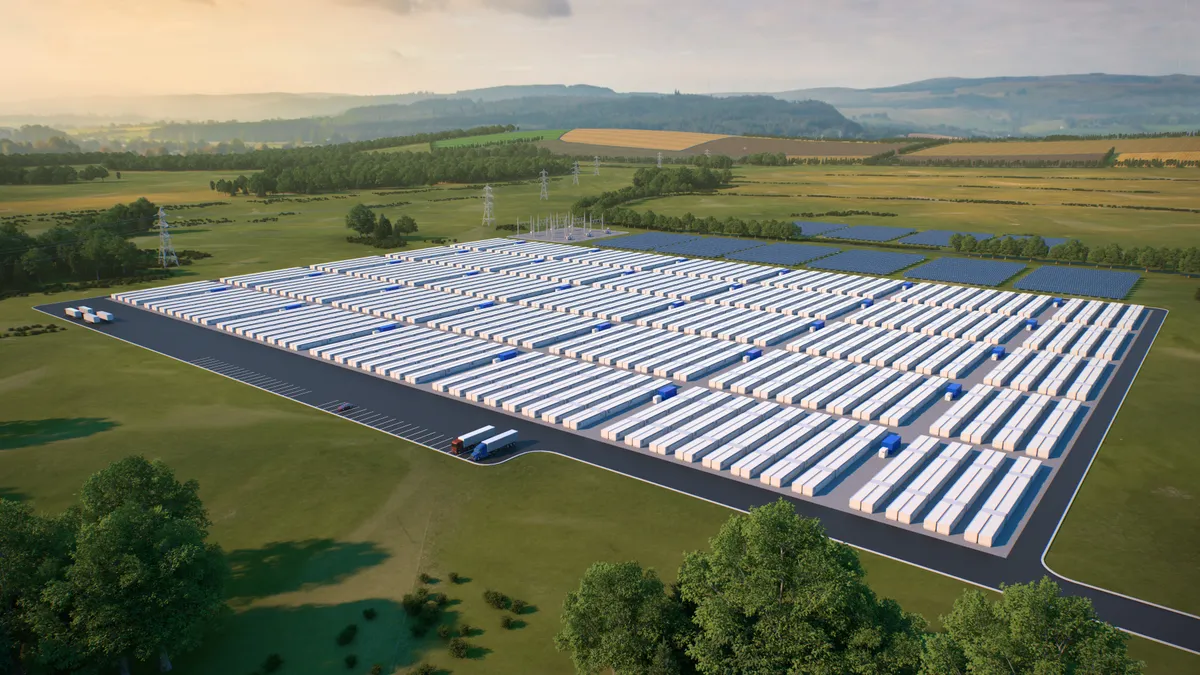Dive Brief:
- Minnesota regulators on Thursday approved a 10-MW/1,000-MWh iron-air battery system to be built by Form Energy for Xcel Energy’s Minnesota utility, Northern States Power, or NSP.
- NSP expects the long-duration energy storage pilot project will be operating by the end of 2025 and will be paired with up to 710 MW of solar at the site of a coal-fired power plant that is being retired.
- The utility expects the project will cost residential customers about 30 cents per month over the project’s 10-year expected life span. The Minnesota Public Utilities Commission imposed a cost cap on the project.
Dive Insight:
The Form Energy battery system — which discharges and stores electricity by converting iron to rust and back again — is slated to be built near NSP’s 1,879-MW, coal-fired Sherco power plant in Becker, Minnesota, according to the utility’s application at the PUC. The utility plans to retire a 682-MW unit at Sherco this year, a 680-MW unit in 2026 and the final 517-MW unit in 2030.
NSP has permission to build 460 MW of solar at the Sherco site and is seeking approval for an additional 250 MW, with the entire solar facility expected to be operating in 2025.
With the Form Energy battery system, NSP expects to gain experience integrating renewable energy onto the grid, Ian Dobson, lead assistant general counsel at Xcel, told the PUC at its meeting.
NSP also hopes to better understand the value of energy storage systems with dispatching during renewable energy “droughts,” mitigating transmission congestion, providing emergency electricity during power outages and reducing peak power costs, the utility said in its application.
The project will support a more just energy transition by building the project in a community directly affected by the shift away from fossil fuel generation, it said.
NSP expects the battery system will be eligible for a 10% bonus tax credit on top of the 30% investment tax credit for siting the project in an “energy community,” according to the application. It may also qualify for a 10% bonus tax credit under the Inflation Reduction Act from Form Energy’s commitment to meeting domestic content requirements, the utility said.
The cost of the project is confidential, but Dobson said it would add about 30 cents to residential customers’ monthly electric bills over the project’s 10-year life. NSP expects to know this summer if it will receive a Department of Energy grant for the project, which could reduce the cost to ratepayers, he said.
The PUC imposed a cost cap on the project unless NSP can show cost overruns were prudent and beyond the company’s control. NSP will recover the project’s costs through a renewable energy rate rider that is included in customer bills.
During the meeting, PUC Vice-Chair Joseph Sullivan said he was concerned about the Midcontinent Independent System Operator’s reductions to the accredited value of renewable energy and that storage could help solar receive “appropriate credit” for its contributions to the grid.
NSP expects construction on the pilot project to start in the third quarter next year and for the battery system to be operating by the end of 2025, Dobson said.
Looking ahead, NSP sees the need for various types of energy storage, including 4-hour, 10- to 12-hour and multi-day storage, Justin Tomljanovic, Xcel vice president for corporate development, told the PUC. The utility company will use its experience from the Form Energy project to help craft integrated resource plans, he said.
However, modeling in resource plans may not fully capture the benefits of energy storage, Steve Rakow, a Minnesota Department of Commerce analyst, said. Long-range modeling smooths out expected electricity pricing so that it doesn’t include the peaks and valleys when storage would likely be used, such as when prices hit $100/MWh or dip into negative pricing, he said.
Xcel plans to install a similar Form Energy battery system at Public Service of Colorado’s Comanche power plant in Pueblo, Colorado. It is also testing in Colorado a 12-MWh liquid metal battery developed by Ambri, Tomljanovic said.
Form Energy, based in Somerville, Massachusetts, broke ground in May on a factory in West Virginia it expects will be able to make 500 MW of batteries annually. It plans to start producing batteries there next year.
It is also developing projects with Great River Energy, Georgia Power and a California consortium that includes Peninsula Clean Energy.
The company’s investors include ArcelorMittal, a steel manufacturer, Breakthrough Energy, an investment firm founded by Bill Gates, and Eni Next, the venture capital arm of Italian energy company Eni.
The U.S. grid may need 225 GW to 460 GW of long-duration storage to support power markets for a net zero economy by 2060, representing $330 billion in capital spending, according to a Department of Energy report, released in March.















